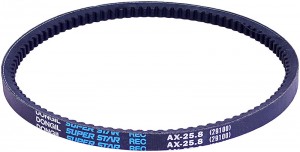
Most modern wheeled vehicles use power steering, which is based on a belt-driven pump. Read about what a power steering belt is, what types of belts there are and how they are arranged, as well as the selection and replacement of these parts in the article.
What is a power steering belt?
Power steering belt (power steering belt, power steering drive belt) - an element of the power steering system of wheeled vehicles; an endless (closed) belt by means of which the power steering oil pump is driven from the engine crankshaft pulley or other mounted unit.
Many modern cars are equipped with power steering (power steering), which creates additional torque on the steered wheels to facilitate driving. The required force on the power steering actuator is created by the pressure of the working fluid coming from a special pump. As a rule, the power steering pump, together with other units, is installed directly on the power unit, and its drive is built according to the traditional scheme - using a V-belt transmission from a crankshaft pulley or other mounted unit.
The basis of the V-belt transmission is the power steering belt, which solves one key task - to ensure uninterrupted transmission of torque from the crankshaft pulley or other unit to the power steering pump pulley in the entire engine speed range (including transient modes) and in any operating conditions. This belt, depending on the type of power steering drive, plays a greater or lesser role in ensuring the performance of the engine and the handling of the car, but in any case, if worn or damaged, it should be changed to a new one without unnecessary delay. And before buying a new power steering belt, you should understand the existing types of these parts, their design and features.
Types, device and features of power steering belts
The drive of the power steering pump can be built according to various schemes:
● With the help of a common drive belt for the mounted units of the engine;
● With the help of an individual belt from the engine crankshaft pulley;
● With the help of an individual belt from the pulley of another mounted unit - a water pump or generator.
In the first case, the power steering pump is included in a single drive of mounted units with a common belt, in the simplest version, the belt covers the generator and the water pump, on buses and trucks, the power steering pump can have a common drive with an air compressor; In more complex schemes, the air conditioning compressor and other units are included in the drive. In the second case, a separate short belt is used, which transmits torque directly from the crankshaft pulley to the power steering pump pulley. In the third case, the torque is first supplied to a water pump or generator with a double pulley, and from these units through a separate belt to the power steering pump.
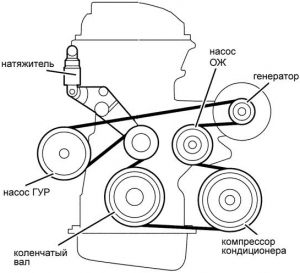
Power steering pump drive with a common drive belt
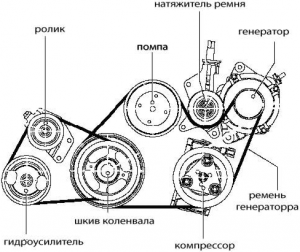
Drive the power steering pump with its own belt with a tensioner
To drive the power steering pump, belts of various designs and sizes are used:
● Smooth V-belts;
● Toothed V-belts;
● V-ribbed (multi-stranded) belts.
A smooth V-belt is the simplest product that is most widely used in domestic cars and buses. Such a belt has a trapezoidal cross-section, its narrow edge is flat, wide - radius (convex), which ensures an even distribution of forces inside the belt when it is bent.
A toothed V-belt is the same V-belt in which transverse notches (teeth) are made on a narrow base, increasing the flexibility of the product without loss of strength. Such belts can be used on pulleys of smaller diameter and work normally in a wide range of temperatures.
A V-ribbed belt is a flat and wide belt, on the working surface of which there are from three to seven longitudinal V-grooves (streams). Such a belt has a larger contact area with the pulleys, which ensures reliable torque transmission and reduces the likelihood of slippage.
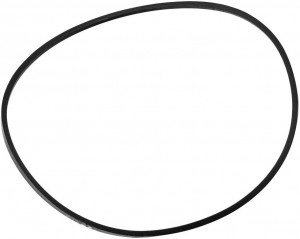
Smooth power steering V-belt
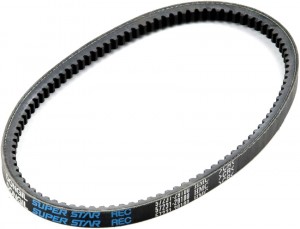
Power steering V-belt timing belt
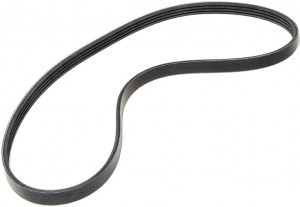
V-ribbed power steering belt
Smooth and toothed V-belts are used in individual drives of the power steering pump from the crankshaft and in pump drives combined with the drive of an air compressor or other unit. Drives on the basis of V-belts are most often used on domestic equipment, as well as on buses and commercial vehicles of Asian production. V-ribbed belts with a large number of streams (6-7) are most often used in general drives of mounted units of the power unit, much less often belts of this design, but with a smaller number of streams (only 2-4), are found in individual drives of power steering pumps from a crankshaft or other mounted unit. Drives with V-ribbed belts are most often used in foreign-made passenger cars.
Power steering belts have a simple design. The basis of the belt is a bearing layer in the form of a cordcord made of synthetic fiber (polyamide, polyester or other), around which the belt itself is formed from vulcanized rubber of various grades. Smooth and serrated V-belts usually have additional protection of the outer surface in the form of a braid made of thin wrapping fabric in two to three layers. To identify the belt, markings and various auxiliary information can be applied on its wide base.
Rubber V-belts of hydraulic boosters for domestic equipment must comply with the GOST 5813-2015 standard, they can be manufactured in two versions in width (narrow and normal cross-section) and have a standardized range of sizes. V-ribbed belts are manufactured according to various international standards and automakers' own standards.
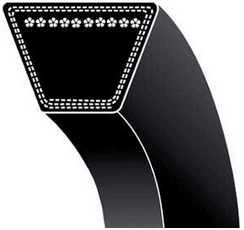
Cut of the power steering drive belt
Issues of selection and replacement of the power steering belt
During the operation of the power unit, all belts wear out and eventually need to be replaced, this fully applies to the power steering belt. Replacement of this belt should be carried out within the time recommended by the automaker, or (which happens more often) when it is worn or damaged. Usually, the need to replace the power steering belt is indicated by the deterioration of the power steering in all modes of operation of the car. Also, the belt must be replaced if cracks are found on it, excessive stretching and, of course, when it breaks.
To replace, you should choose a belt of the same type that was installed on the car earlier. For new vehicles, this must be a belt of a certain catalog number, and after the expiration of the warranty period, you can use any belts with suitable characteristics - type (V-plate, V-ribbed), cross-section and length. If the power steering pump belt has a tension roller, then it is necessary to purchase this part immediately along with fasteners. It is not recommended to leave the old tensioner, as this can lead to heavy wear or damage to the new belt.
Replacement of the power steering belt should be carried out in accordance with the instructions for repair and maintenance of the vehicle. On motors with an individual drive of the power steering pump and without a tensioner, it is enough to loosen the pump fastening, remove the old belt, install a new one and tension the belt due to the correct fastening of the pump. If a tension roller is provided in such a drive, then first of all it is dismantled, then the belt is removed, a new one is put in its place, and then a new tensioner is mounted. In engines with a common drive of attachments, the belt is replaced in the same way.
In some cases, the work of replacing the belt may be complicated by the need to perform additional operations. For example, on many engines, you must first remove the alternator drive belt, and then replace the power steering pump belt. This should be taken into account and immediately prepare the appropriate tool.
The most important thing when replacing the power steering belt is to ensure that it is properly tensioned. If the belt is over-tensioned, the parts will experience high loads, and the belt itself will stretch and wear out in a short time. With a weak tension, the belt will slip, which will result in a deterioration in the operation of the power steering. Therefore, it is necessary to carefully follow the recommendations given in the instructions, and, if the father-in-law has such an opportunity, use a special tool to ensure normal tension.
With the right choice and replacement of the belt, the power steering will provide comfortable driving in all road conditions.
Post time: Jul-14-2023
